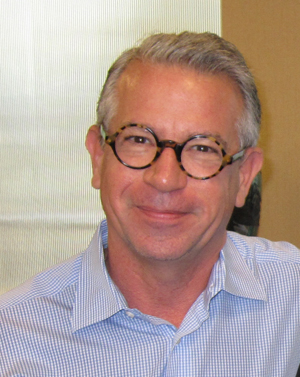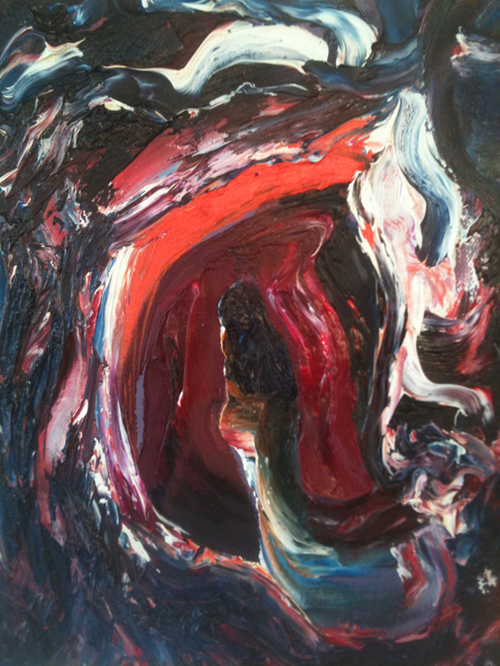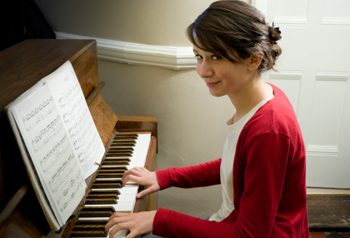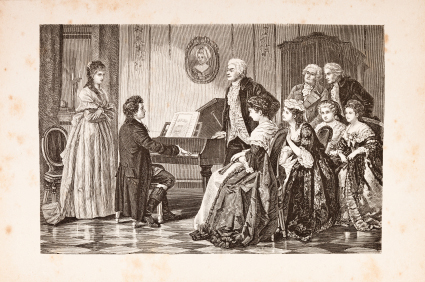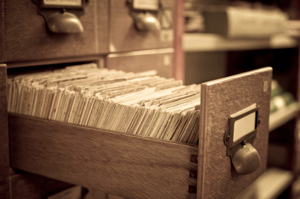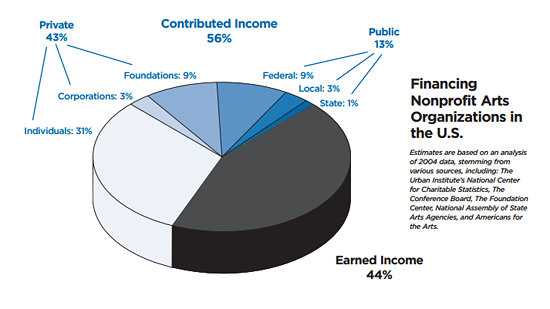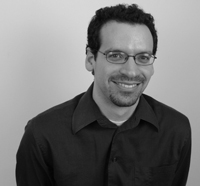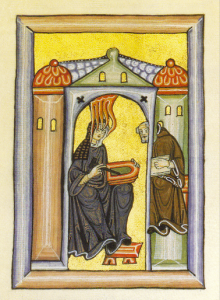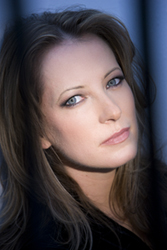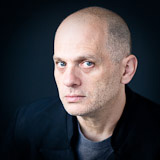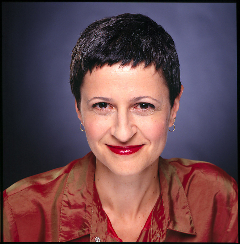Sometimes, I envy my composition students. I loved being a student. I remember sleeping in until noon. That was awesome. I remember the excitement of learning new things about new music things, and writing new things at all hours of the day and night. I remember we ticked away on malleable composer-clocks. That was fabulous. Time felt easily scheduled and free. In 2002, I left school and somehow continued to write things; yet I wrote under a new umbrella of anxiety and discomfort. I did not have a hold on how I could control and shape my writing time.
Over the course of the last decade—a path that runs through a handful of adjunct teaching jobs, having a kid, living and freelancing in New York City, and now nearing my fifth year on the other side of the desk as a full-time faculty composer—it became necessary to snap my Dali-glob of a composer-clock into a strictly delineated circular grid. Apart from the time we take for performances, networking, promoting our work, etc., I am fascinated by how we composers inhabit our composer-clocks. Writing time: where is it, when is it, how is it.
In 2004, I had a late-night drink with composer Betsy Jolas after we had gone to hear the St. Petersburg Chamber Choir present Rachmaninov’s Vespers. Betsy spoke of the first time she met Stravinsky, her summers at Tanglewood, and her children. I asked her, “How did you find time to write while caring for young kids?” She explained: First, one makes time to write; second, she had a special attic, all her own. She would sneak upstairs at 3 a.m. and write until the children awoke. She called it “my precious, protected, space and time with my music.”
I grew up in beautiful Boulder, Colorado, in a house built into a hill nestled beneath the Flatirons. Along with a perfect view of the south side of I.M. Pei’s stunning National Center for Atmospheric Research (NCAR) building, our house had a funky, small, modernist layout. The “yard” consisted of multiple levels with rock steps leading to little curious outside-spaces to explore. I often awoke at night to one cricket singing, deer rustling, aspen leaves twinkling in the breeze. It was quiet.
The most dazzling place I knew as a kid was my mom’s parents’ house in Northern Indiana’s Dune Acres, on the shore of Lake Michigan. With architectural characteristics of Bauhaus and the International Style, its layout was supreme funkytown: cool angles everywhere, half-walls, a bewindowed breakfast nook that jetted out over trees, a “yard” of multiple levels with rock steps leading to secret, small, side patios. I often awoke at night to the steady waves whispering on the beach. It was quiet.
I love visiting friends’ and colleagues’ “places of work.” The way we as individuals shape the environments devoted to our creativity is telling. Our spaces are windows into who we are as creative thinkers: precisely where the piano or keyboard is placed; if there is a writing table, its size, shape, and location; what, if anything, one chooses to hang on walls. Compelling among these spaces are those in New York City—workspace design gets mighty quirky in minimal square-footage. (Mine was seven-feet by three-feet when I lived there.) There is also a fun-ness in our dealing with our “stuff”: some studios are so pristinely organized they verge on being hermetically sealed; some have scores of scores, books, sticky notes, instruments, electronic gear, piles of paper seemingly strewn haphazardly. We all have our ways of organization, organized chaos, or preferred chaos here.
Throughout the apartment-hopping days of college to today, I have meticulously laid out my writing spaces. I also obsessively studied the history of architecture. I wrote, and still write, music inspired by buildings. I now understand the symbiosis of all of this: a thirty-eight-year evolution of a cognitive comfort zone, deeply rooted in, and informed by, the architecture of the spaces I inhabit. To ease the struggles of writing, I devote varied compositional activities to specific locations. These days, the writing time I have in my office at school, or in a coffee shop, is devoted to proofreading, editing, and making to-do lists. Large- and small-scale imagining, choosing notes, pacing while considering what comes next, I do best in my tiny home studio. It is a nook; it looks west over the Ann Arbor treeline, and its walls form a funky-angled trapezoid. The space feels easy.
In 2007, I caught up with composer Chen Yi over lunch. She was immersed in a busy season full of travel. I asked her how she manages to keep up her writing with her packed schedule. She told me she often writes on planes, and lit up at the possibility of the middle seat being empty, allowing her to spread out her work.
Whatever we have, whatever we choose to do, fills our lives. Composers with kids are no more busy than those without, composers who teach are no more busy than those who do not, and composers with multiple converging deadlines are no more busy than those with lengthy stretches of time between. Each of us is simply different-busy. The obesity of to-do lists ebbs and flows in seasons of varied intensities for everyone.
Student composers are a particular sort of different-busy, in part because they are still gaining a multi-textured self-awareness, one not limited to their evolving creative capacities, but also including the development of time-management skills. When a student opens a lesson with, “I didn’t have time to write much this week,” we talk about what that means: Are they scheduling writing time? Are they able to stick with that schedule? Do they protect their writing time from external interruptions (e.g., turn the phone off)? How are they using that time?
I believe it is important, particularly for young composers, to commit to a diligent habit of writing every day. Seth Godin has a great blog post about every-day writing, and what applies to writers of words is also relevant to writers of music. Godin’s blog is primarily focused on small-business marketing strategies. I like his posts because they are short, interesting, and frequently contain little gems of creative wisdom that resonate with an artist’s life. I often check @ThisIsSethsBlog on Twitter first thing in the morning, which one day revealed this delicious irony.
Over the last few years, my primary writing time has settled into fairly consistent spans of late night or early morning hours, which was not merely born out of a necessity from “much else to do” during the day. Although managing my own different-busy—I parent, I compose, I teach—my choice of these wee hours for creative focus is also informed by the sonic spaces and thinking-time of my youth; a propensity as a kid to enjoy awake-time when everyone else was asleep, and possibly most importantly, my efforts to carve out a specific space with a veil of silence: I need silence to write. Within the mountains of emailing, meetings, proofreading, editing, phone-calling, and even fun-having, I am comfortable allowing for interruptions. Given that which fills my life, my wee hours are best suited for the kind of writing that warrants its own, protected, space and time.
The term “writer’s block” should be stricken from the universe as a term. Composing is a multifaceted activity, one which requires the use of thinking-muscles, and one must figure out how to use those muscles in comfortable, useful ways. It troubles me to hear young composers express fear that creative thinking-muscles might atrophy. They get this notion from someone somewhere, and it can be paralyzing. In addition, telling a young composer they should write every day for at least an hour, and leaving it at that, can be equally paralyzing.
What is writing time, and how does one fill it? If not feeling particularly note-y or conceptual-y, take a walk for twenty minutes and think about titles. This is writing. Have a pile of empty bars waiting to become a contrasting section? Hit a coffee shop for an hour and make a list of adjectives describing how it can, or cannot, sound. This is writing. If staring at the blank page when starting a piece, unsure of what to do: relax, settle in some place comfortable, and simply imagine what it can be, how it can sound. Over and over, imagine it, without putting anything on a page. This is writing. An afternoon roaming a museum pondering visual likes and dislikes: this is writing. Spending fifteen minutes on a bus considering what piece one would write if one could write anything for any forces: writing.
Mentors, friends, and books suggested some of the above to me when I was a student, yet none put it like so: Make time for your writing; vehemently protect it; set a timer if it helps; find or create spaces solely devoted to writing; pay attention to how your writing sensibilities change, and respond to them; during your writing time you are available only to your creativity. P.S. Turn off your phone.
Holy smokes the world provides a lot of input. In some ways it is super cool. Our ability to rapidly disseminate information is mind-blowing, and can be useful. I love reading composers’ blogs, many of which explore our efforts to “filter out the noise” as we navigate the layers filling our different-busy schedules. The most poignant shift in my daily composer-clock ticked into place in 2005 with the birth of my son. Turn-on-a-dime time, people. Baby asleep = hurry up and write / Baby awake = stop writing. While I have little memory of choosing the notes I chose for the first two years of my son’s life, it was a tremendously informative time in shaping how I write now. Time to write = writing time. Period. I am still working on filtering out the noise during non-writing times; yet I am grateful that at least I am aware when the noise is fading in.
I wrote my first music at my grandparents’ Dune Acres house. We visited there most summers of my childhood. When the weather held, we spent long lazy mornings at the lake. After lunch, while others napped, I would sneak outside to my secret side patio. I made up songs, sang with the crickets, waves, and trees. It was the beginnings of my precious, protected, space and time with my music. Sometimes, I went out alone in the rain.
***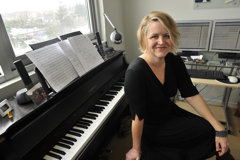
Composer Kristin Kuster “writes commandingly for the orchestra,” and her music “has an invitingly tart edge” (The New York Times). Kuster’s music takes inspiration from architectural space, the weather, and mythology. Recent CD releases include Two Jades with violinist Xiang Gao and the UM Symphony Band, and the title work on the PRISM Saxophone Quartet’s New Dynamic Records CD Breath Beneath. Kuster’s music has received support from such organizations as the American Academy of Arts and Letters, the Sons of Norway, American Composers Orchestra, the League of American Orchestras, Meet The Composer, the Jerome Foundation, the American Composers Forum, American Opera Projects, the National Flute Association, and the Argosy Foundation. Born in 1973, Kuster grew up in Boulder, Colorado. She earned her Doctor of Musical Arts from the University of Michigan, where she now serves as Assistant Professor of Composition.


